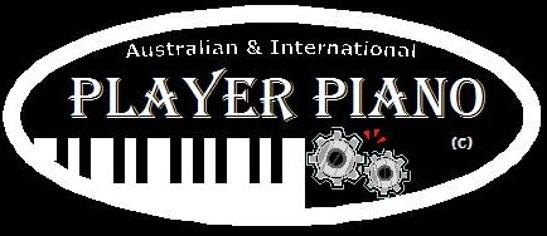
The Gulbransen Triano Reproducing Player Piano System and other pictures.
“Triano" Wins Prize
in Gulbransen Contest
The Gulbransen Triano, "The
Mrs. Margaret Woodbine Black is a daughter of Dr. W. F. Kippen, a Spokane
physician. She graduated from the North
Central High School of Spokane in
1918, after which she attended the University of Idaho
at Moscow and later graduated from Cheney
Normal School of Cheney,
"A mere letter of thanks seems very inadequate at this time. I am surely proud and happy to learn of my good fortune in having won 'the three-way piano,' and I wish to thank you for having made possible my chance to win such a wonderful prize.
Gratefully yours, (Mrs.) Margaret Black."
The judges in the contest were C J. Levin, of the Kranz-Smith-Hammann-Levin Co., Baltimore; Henry D. Sulzer, of Vanderhoof & Co., advertising agents of Chicago, and A. H. Boettcher, patent attorney of Chicago
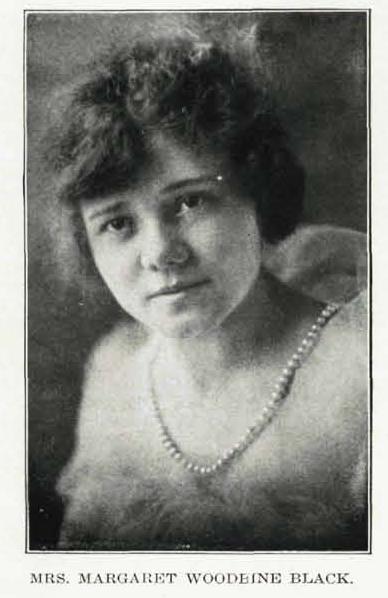
Courtesy of: The Music Trade Review
Recordo style expression controller 1928. Component of the Gulbransen Triano.

Control unit activates the Recordo and switches various peripherals on or off according to the mode of play selected.
My own Gulbransen Player: An excellent example of the Gulbransen 'Triano' Combination Registering & Reproducing Piano. Originally purchased in 1928 for use in the Balmain Hotel, Sydney. Fortunately it survived to become mine to look after for a while. I'm fairly certain it will outlive me. Fully restored.
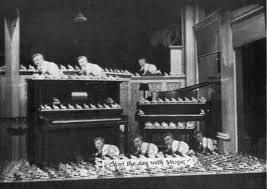
A well restored Gulbransen is a joy to pedal. It is so efficient in its use of suction, due to the smaller suction channels in the stack, that you can literally feel each note play though your feet. Mass produced, but built to an exceptionally high standard. Arguably the most successful player piano manufacturer ever. Gulbransen also manufactured complete mechanisms for placement in other brands of piano. One of the most successful advertising campaigns in history was the Gulbransen 'Easy to play' logo that featured a baby pushing down on a treadle with one tiny hand. An animated replica of the baby in papier-mache, was supplied to most Gulbransen distributors.
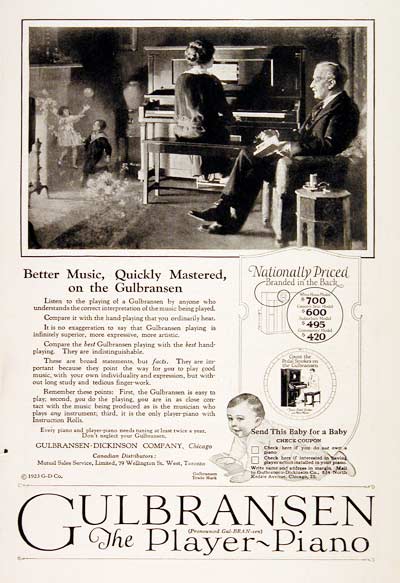
Gulbransen Tubing Schematic. + Components; Specifically to suit the Triano Model 1927-8
Liebig Reed Organ before and after restoration:
This little reed organ must have been one of the first DIY packed units. Everything unscrews, I can only imagine that it arrived in a crate (probably with German instructions).
Nowhere near as elaborately decorated as similar sized Parlour and Church organs of the period, some of which display magnificent Victorian fretwork and carvings.
Circa 1928.

Before Restoration
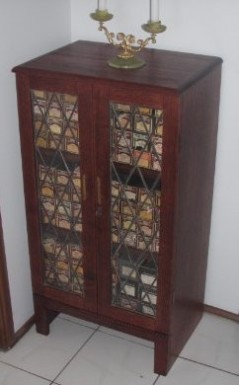
After Restoration
ROLL CABINETS
One of the items to complete your player piano ensemble is the roll cabinet. Becoming more difficult to find, but still available, various models hold between 100 and 250 standard size rolls. They look great when restored and will keep your roll collection in good order. Easily repaired and refinished, you can find them, as I found this, on eBay.
It required 5 new glass diamonds, which were easy to cut with the inexpensive glass cutting tools available at any good hardware store, glass of the correct thickness was obtained. The finish is Mahogany stain and two coats of Danish oil, very easy to apply and gives a lustrous glow, much more suited to smaller furniture than high gloss. No veneer here, it's solid timber and the grain can be sanded with ever increasing fineness of sandpaper, to produce the wonderful grain effects so sought after in antique wooden furnishings.
WARDROBES
Small wardrobes from the '20's can be obtained from opportunity shops and will, with shelving added, accommodate a decent roll collection easily. These items are inexpensive and remove the cluttering rolls from the top of your piano and saves storing your rolls in boxes. Obtainable in many period styles that will grace the style of your piano.
Gulbransen 'Suburban' Pedals and Bellows.
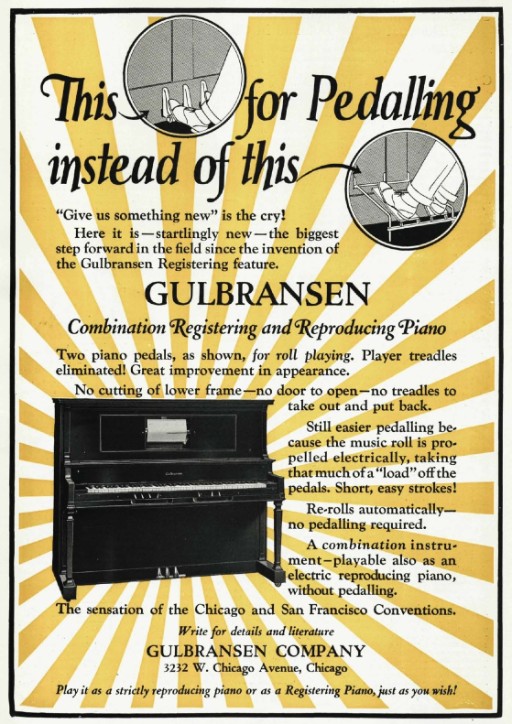
Motor Player Corporation vacuum pump and motor governor.
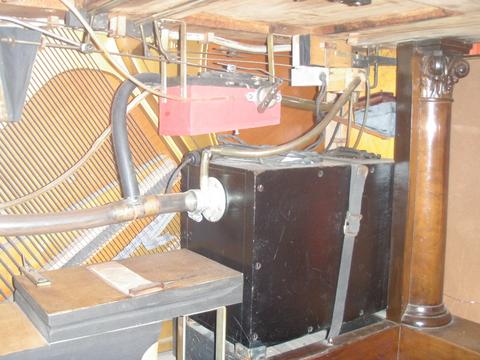
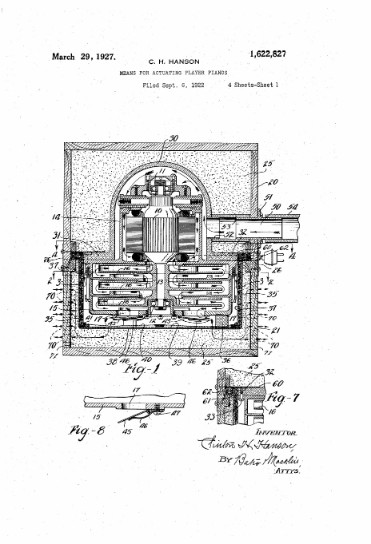
The above patent drawing of an Electora Vac Pump was found on http://www.freepatentsonline.com
I recommend this site for finding details and drawings of obscure player components. Can be very handy when you can't work out what goes where. Plus it's a very interesting site to look for basically any patent going right back to the late 1800's

Automatic re-wind & re-play pneumatics. An essential peripheral in an electric system. Stops rolls being dragged off their core should the player be unattended. Unfortunately, not all rolls feature the trigger perforation for re-wind, so care must be taken.
The Recordo system is found in many different forms in many different makes of player. While it is more basic than the Ampico, Duo-art or Welte, it still imparts lifelike expression to the music, should a Recordo coded roll be played. Instead of regulating the amount of suction to each side of a divided stack, it lifts bass or treble hammer rails by way of two pneumatics also controlled by perforations in the Recordo roll*.
The Recordo system used in the Gulbransen Triano piano, delivers an excellent quality reproduction, this system, which is far less complex than the best known reproducing pianos, performs the dynamics encoded in a Recordo roll with ease. In my opinion, there is very little difference in performance compared to other systems. The system achieves 16 dynamic levels.
*Some say that the Recordo system is not a 'reproducing' system, I disagree. Basing their ideas on the fact that the stack is not split and therefore not controlled by separate dynamic controls for bass and treble. Yet in fact the system is split by a divided hammer rail that controls bass and treble dynamic levels by lifting the hammers closer to the strings or further away, as coded. This works in conjunction with the Recordo dynamic controller. A well coded roll will be difficult to distinguish, in performance, from any other 'reproducing' system.
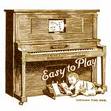
An Interview With: Axel. G. Gulbransen, President of the Gulbransen Piano Company.
DIFFERENT PRICES IN PIANO LINES
A piano manufacturer can satisfactorily produce low priced
and high priced instruments in one plant, and many convincing reasons are cited: The doubt is often expressed, and probably many more times left
unspoken, as to whether or not it is possible to satisfactorily manufacture low
priced and higher-priced products in the same plant.
We might as well face the fact that this question is with us, and it is one that I am glad to answer. It has been my observation over a period of years, that the concerns that have done outstanding work from the quality stand point, have been helped by higher volume sales on a lower priced commodity.
To do research work, to constantly test, improve and devise new methods, make new dies, new patterns and to install new manufacturing equipment, brings about a very heavy drain on the financial resources of any company. If the sales of high-priced products were only to take care of these financial needs, many of the finest developments would never progress beyond the development stage, and remain merely an idea. Realization would never come about. Many of the great inventions of the day, much of the progress in the piano business and in the music industry, would never have taken place were it not for the financial channels opened up by a moderate priced list of instruments.
Taking the Gulbransen line, for example, because I know it best, there are the two extremes of the Minuet Model upright piano at $295 and the Triano Period Model grand in walnut at $2,400. The latest instrument represents very marked improvements and developments in the field of roll played pneumatic instruments. Through this piano the world has been given an instrument that can be played with personal expression through ordinary piano pedals, instead of player treadles. The roll box has been moved from under the keyboard to back of the music rack, which represents many advantages. A mechanism is incorporated in this instrument, which enables it to be used for strictly electric reproducing playing or for playing by foot pedals. These things represent mighty progress in the playing of the piano. Backing them are years and years of study and experimentation. Hundreds of devices and ideas had to be brought into being and discarded for improvement, before the final perfected instrument is built.
Dependent on its own output, these results could never have been attained. It would not be financially possible, nor practical.
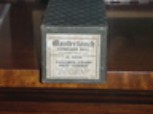
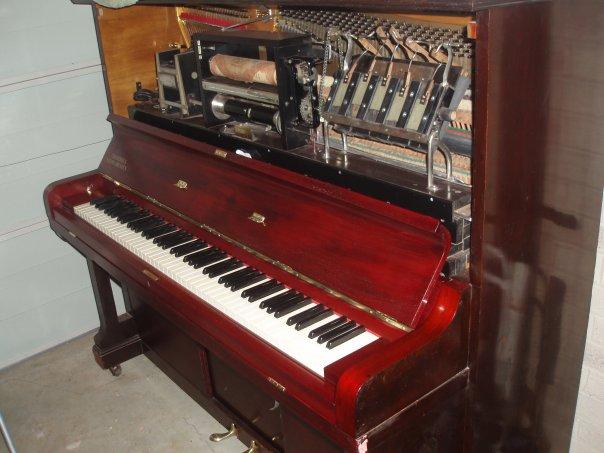
This Stems of Dresden Grandiola, contains an early Autopiano player action, information about these and other makes from Dresden is next to impossible to find, due to the destruction wrought by WW2. However, it is an Autopiano and is a relatively easy action to repair. German pianos were and are among the finest in the world.
(donated to local high school)
Feel free to contact me at the email address below, if you would like to submit a photo of your player piano or other mechanical musical instrument (along with an explanation of the item, owners name, country, etc), for inclusion in this presentation. Please only submit photo's that are your property.
Pedal Duo-art system, restored and fitted into a German Zimmermann Player. The Duo-art mechanism was orphaned from it's Steck piano some years ago.
Duo-art tracker bar installed in a Zimmermann.
Zimmerman Player, a beautifully made piano, a large number were imported into Australia in the 1900's
(donated to local primary school)

I don't know why, but these late 19th century swivel piano stools with glass ball & claw feet, appeal to me. If they were easier to find and not quite as expensive, I'm sure I'd have a house full of em. Available in three or four leg, a variety of different woods and beautifully turned wood. These little stools add style to any upright piano. I actually have two, and they look great when re-finished.
Ampico/Amphion Transmission